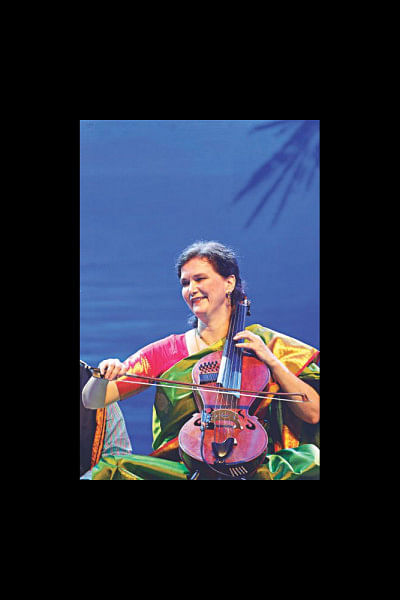“Classical music should be accessible to every child”

The cello, a bowed string instrument of the violin family, has been one of the major components of Western classical music, be it in chamber or orchestral music. Dutch cellist Saskia Rao-de Haas brought her signature Indian classical cello to the Bengal Classical Music Festival this year, giving the Dhaka audience a new sound to cherish.
Saskia first came to contact with Indian classical music during her Masters in ethnomusic at the Rotterdam Conservatory of Music where she studied under Indian classical flute legend Pt. Hariprasad Chaurasia. She came to India and studied Indian classical further, redesigned the cello to play Indian classical ragas on it, and has been performing in India and worldwide.
After her fascinating debut performance at the festival, Saskia spoke briefly to The Daily Star about her inspiration, instrument and more.
What are your first impressions of Dhaka and the festival?
Saskia: I am so happy to be a part of this; it's such an amazing experience to be here. The audience is so very warm, kind and welcoming. From the moment I landed here, it has been a really good experience.
What inspired you to play the cello in the Indian classical form?
Saskia: (laughs) The original plan was I wanted to know a little more about Indian music. So since I was already a cellist, this was the easiest way … not knowing it would really change the whole course of my artistic expression. If you know a little, you want to know more and more. I gradually got drawn into it.
It's said that the sarangi is the instrument that sounds the closest to the human voice. In your performance today, one of the first notes you hit really resembled a human voice. Could you tell me a little about the timbre of the sound of the cello?
Saskia: Absolutely. It is exactly like the male voice. It is the same family as the violin, but the depth gives it that sound. You mentioned the sarangi; the pathos it has in its tone, the cello has it as well. In any Indian film when there is a very sad scene we'll hear the sarangi. Similarly when there is a sad or dark scene, you'll hear the cello as well. So the sarangi and the cello are interestingly related in the family.
You are the only musician of your kind playing this instrument. How do you plan to pass it on?
Saskia: Musicianship is not about ownership. I am very passionate about music education. I teach cello both in India and abroad. But even more than cello, I am passionate that classical music is accessible to every child. Every child should have a foundation in classical music; let me provide that to them and they will automatically choose more instruments. Now we see the children only choose the guitar or keyboard. When we open up the musical knowledge -- in a fun, age appropriate way… we can't teach in the same way as a hundred years ago happened. We need to adapt it to this time. So yes, I want to continue that.
Along with her husband and frequent musical collaborator noted sitarist Pt. Shubhendra Rao, Saskia has established a music education programme titled Sangeet4all (based in New Delhi), which serves schools and families throughout India by providing music curriculum grounded in Indian classical music with a global outlook. The curriculum includes original songs, stories and activities for introducing beginner to advanced musical concepts of Indian music in a way that is appropriate for early childhood education. The curriculum is in line with the guidelines of Indian CBSE board for primary performing arts education.

 For all latest news, follow The Daily Star's Google News channel.
For all latest news, follow The Daily Star's Google News channel. 



Comments